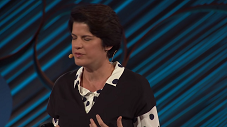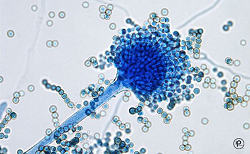To view the original article, click here.
Hello. I am Dr Tom Chiller, deputy chief of the Mycotic Diseases Branch at the Centers for Disease Control and Prevention (CDC). I am pleased to talk to you about antifungal resistance, a topic that needs more attention.
Although antibiotic-resistant bacterial infections are a widely recognized public health threat, much less is known about the burden and consequences of drug-resistant fungal infections. Since the discovery and widespread use of antibacterial medicines in the 1960s and with increasing numbers of high-risk patients, we have seen the emergence and increased rates of serious invasive fungal infections.
Over the past decade, we have made some progress in combating healthcare-associated bacterial infections. Improving care of central venous catheters and a focus on antibiotic stewardship programs have led to decreases in bloodstream infections caused by resistant bacteria, although we still have a ways to go. However, those decreases have resulted in the fungus Candida becoming the most common cause of healthcare-associated bloodstream infections in many hospitals across the United States.[1] The development of a few classes of antifungal agents has given us the ability to treat these invasive infections, but just like bacteria, some fungi have developed resistance and no longer respond to the antifungals that are used to treat them.
Some types of Candida are becoming increasingly resistant to first-line and second-line antifungals—namely, echinocandins and fluconazole. Approximately 7% of all Candida bloodstream isolates tested at CDC are resistant to fluconazole. Most of these isolates are Candida glabrata, 14% of which are resistant.[2,3] The good news is that CDC’s surveillance data indicate that fluconazole resistance has remained fairly constant over the past 20 years.[3,4,5]
In contrast, echinocandin resistance appears to be on the rise, with 3%-5% of C glabrata isolates being resistant to echinocandin.[2] Isolates tested by CDC before 2004 showed no resistance, so this resistance has emerged after the echinocandins became widely used. Today, the prevalence of echinocandin resistance is more than 10% at some hospitals and is continuing to increase.[6,7]
Finally, a growing concern is the presence of multidrug-resistant Candida infections (those that are resistant to both fluconazole and echinocandins), because few treatment options remain, other than amphotericin B. Not surprisingly, there is growing evidence to suggest that patients who have drug-resistant candidemia have worse outcomes than patients who have susceptible infections.[8,9]
Some studies have indicated that antibacterials may also contribute to antifungal resistance; this could occur for a variety of reasons, one of which is that antibacterials reduce bacteria in the gut and create favorable conditions for Candida growth.[10] It’s not yet known whether decreasing the use of all or certain antimicrobial agents can reduce Candida infections, but appropriate use of antibacterials and antifungals is one of the most important factors in fighting drug resistance.
Although most of the resistance that we are concerned about is in Candida species, resistance in other fungi also occurs. I want to highlight the emergence of azole resistance in Aspergillus fumigatus. Since its approval in 2002, the antifungal agent voriconazole has been the primary treatment for invasive aspergillosis. However, more than a decade ago, several countries in Europe began seeing an increasing amount of azole-resistant Aspergillus fumigatus.
Studies in Europe suggest that resistance in Aspergillus may be partially driven by the use of agricultural azoles, which protect crops from fungal diseases.[11,12] Prevalence as high as 30% has been seen in some hospitals in Europe.[13] Patients with these resistant isolates had a much higher mortality—closer to 90%, compared with approximately 40% for patients with susceptible strains.[14] Resistant isolates have been now also identified in the Middle East, Asia, Africa, South America, and most recently in the United States.
The Mycotic Diseases Branch at the CDC is collecting isolates of A fumigatus for US surveillance of resistance. We encourage clinical labs to send samples to CDC. Please refer to the Web resources below for instructions on submitting isolates.
In summary, we encourage hospital executives and infection control staff to:
- Assess antifungal use as part of their antibiotic stewardship programs; and
- Ensure adherence to guidelines for hand hygiene, prevention of catheter-associated infections, and environmental infection control efforts.
We encourage physicians and other hospital staff to:
- Prescribe antifungal medications appropriately;
- Ask their laboratories to routinely determine the species of every Candida sterile body site isolate if it is not reported, and if C glabrata is found, consider ordering antifungal susceptibility testing;
- Document the dose, duration, and indication for every antifungal prescription;
- Be aware of local antifungal resistance patterns; and
- Be active in efforts within your hospital to improve antifungal prescribing.
Medical and Patient education videos
-
Title
Description
-

Stanford big data techno-optimist and internist Russ Altman shows us how the power of machine learning in drug development is helping us understand adverse medication effects.
-

Psychiatrist and addiction expert Judson Brewer shares groundbreaking research on the mechanism of mindfulness practices that effectively help quell cravings of all kinds, including smoking.
-

Global public health worker and communications expert Christine McNab illuminates the story of how she combined her passions and partnered with the Gates Foundation to create what might be the most artistically crafted vaccine promotion campaign ever.
-

At 37 years old, physician, public health advocate, entrepreneur and grassroots organizer Vivek Murthy is one of the youngest U.S. Surgeon Generals in our nation’s history, and the first one of Indian descent. Prior to his confirmation, he was a physician at Brigham and Women’s Hospital and a Hospitalist Attending and Instructor in Medicine at Harvard Medical School. He was President and cofounder of Doctors for America, a national grassroots organization of 15,000 medical students and physicians advocating for high-quality and equitable health care.
-

Who knows better how to heal a community than those who inhabit it? America Bracho’s Latino Health Access trains local promotoras to teach neighbors and friends how to be healthy.
-

The state of your mind might be dependent on the state of your gut
-

Using soil fungi to combat livestock parasites in Australia. Ugandan smallholder dairy farmers show signs of comeback. New systems of aquaculture to benefit fish farmers in Thailand.
Fungi Can Combat Livestock Parasites
BBC World Service 1996
-

The rice blast fungus genome has been sequenced and will be used to develop resistant strains of rice. Nasa’s Spitzer telescope has found an asteroid around a sun like our own – but are there planets, too? As the hurricane seasons approaches in Amercia, scientists are trying to predict how bad it will be. Why “don’t worry, be happy” is practical medical advice.
-

In a few years, 70 million trees could be lost in the UK to ash dieback. Kew Gardens scientists are collecting samples from infected trees, to understand whether genes in ash may harbour resistance to the disease.
-

UK Fungus Day
October 12th is UK Fungus Day, a chance for us to celebrate these cryptic, often microscopic, but essential organisms. Usually hidden away inside plants or in soil (or if you’re unlucky, in between your toes), fungi have largely been growing below scientists’ radars for centuries. Mycologists still don’t know anything close to the true number of fungi that exist on the planet. About a hundred thousand have been formally identified, but it’s estimated that anywhere from half a million to ten million species may exist. This dwarfs, by several orders of magnitude, how many mammals there are on Earth. And, increasingly, we’re realising quite how crucial fungi are to the functioning of our ecosystems. Head of Mycology at The Royal Botanic Gardens Kew, Bryn Dentinger, explains how valuable fungi really are.Nobel Prizes 2014; Gauge; Genetics and Diabetes; UK Fungus Day
BBC Radio 4 2014
